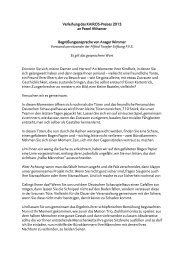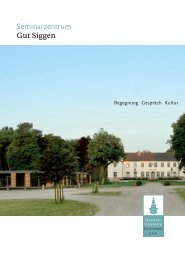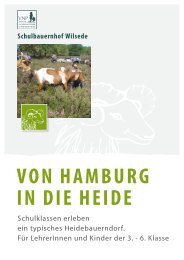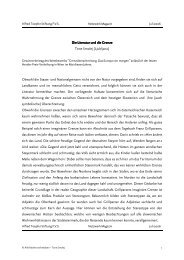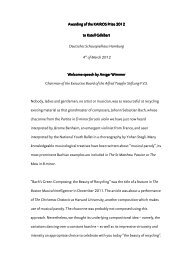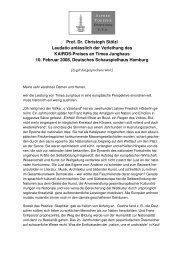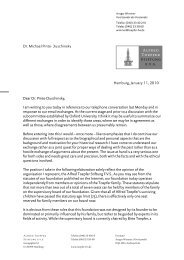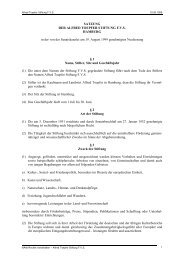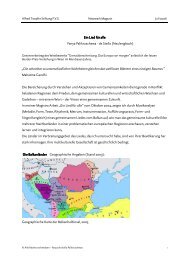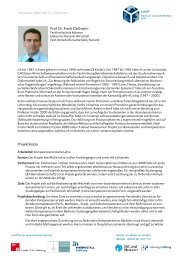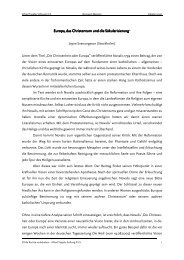0.1 Titelbild - Alfred Toepfer Stiftung F.V.S.
0.1 Titelbild - Alfred Toepfer Stiftung F.V.S.
0.1 Titelbild - Alfred Toepfer Stiftung F.V.S.
Sie wollen auch ein ePaper? Erhöhen Sie die Reichweite Ihrer Titel.
YUMPU macht aus Druck-PDFs automatisch weboptimierte ePaper, die Google liebt.
Netzwerkmagazin 12|08<br />
capabilities and limits, but also to examine<br />
their ability to learn and the ways it<br />
develops. Because children’s cognition is<br />
mostly based on experiences of here and<br />
now, it is important to choose subjects<br />
that are essential and current for them.<br />
In order to become a lifelong learning<br />
environment, museums should try to<br />
encourage children to everyday use of<br />
the museum. To involve children, the<br />
museum has to find a way to consider<br />
their various needs in exhibition planning.<br />
A solution to this problem might<br />
be child inclusive exhibition design.<br />
What is child inclusive e exhibition de-<br />
d<br />
sign?<br />
It is an approach to the design of exhibitions<br />
that are accessible to and usable by<br />
not only adults but also children with all<br />
their limits, capabilities and needs.<br />
This derives from inclusive design,<br />
which is a model mostly considered in<br />
relation to elderly and disabled people.<br />
According to this model, a person is<br />
excluded by design, when the demands<br />
of a product usage go beyond the capabilities<br />
of the user. In the museum context,<br />
this model also relates to children<br />
who do not comply with common design<br />
standards and are therefore often<br />
excluded. There are several ways of<br />
improving museum learning in the<br />
terms of design requirements including<br />
the creation of child friendly environments,<br />
preparing clear orientation and<br />
labelling system, organisation of child<br />
Texte publik gemacht<br />
suitable spaces, usage of different media<br />
and senses, and advertising campaigns<br />
for children and child centred web design.<br />
Strategic concept<br />
Taking these suggestions into consideration<br />
and working in cooperation with<br />
the Roemer- und Pelizaeus Museum<br />
Hildesheim, I have developed an additional<br />
layer for children for the permanent<br />
exhibition ‘Ancient Peru: Cultures<br />
in the realm of the Incas’. This exhibition<br />
aims to give an impression of the cultural<br />
diversity of old Peru over the centuries.<br />
It is targeted to adults, mostly to<br />
specialists interested in the subjects and<br />
well informed citizens. Children are<br />
considered only in the terms of school<br />
groups or as participants of workshops.<br />
For this reasons, the main focus of my<br />
project lays on attracting the attention<br />
of children and families to the exhibition<br />
as well as awakening an interest in different<br />
cultures and nations. It is also<br />
essential to make the old Peru exhibition<br />
more appealing by the involvement of<br />
different senses and media. By following<br />
these goals, the position of the museum<br />
as a lifelong learning environment can<br />
be established and strengthened.<br />
The project is targeted to the group of 8<br />
to 12 year olds. This age group is already<br />
able to actively participate and understand<br />
the subjects presented. Through<br />
supplementing the needs of children in<br />
51<br />
<strong>Alfred</strong> <strong>Toepfer</strong> <strong>Stiftung</strong> F.V.S.<br />
www.toepfer-fvs.de



